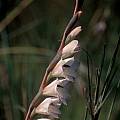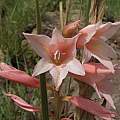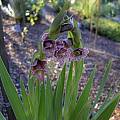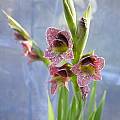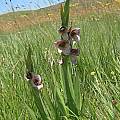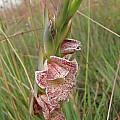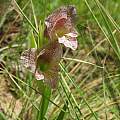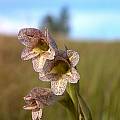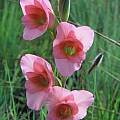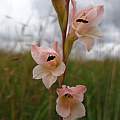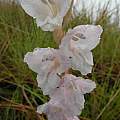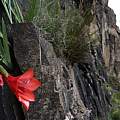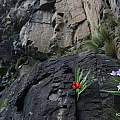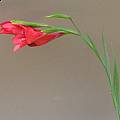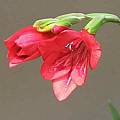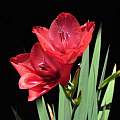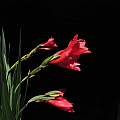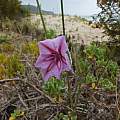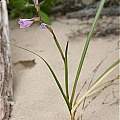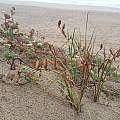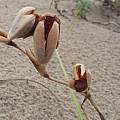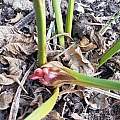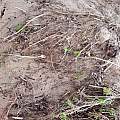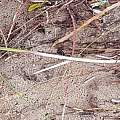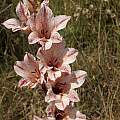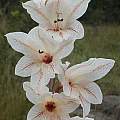Summer rain Gladiolus are mostly from the eastern part of South Africa. They generally like their summers wet and their winters dry, but just exactly how wet and how dry may vary widely depending on on the exact location of origin. Among the summer rain species are some of the most frost hardy of the African species, but as most tropical African Gladiolus follow a summer rain pattern as well, some are quite frost tender.
Page 1: G. albens... Page 3: G. inandensis... Page 4: G. mortonius... Page 5: G. rehmannii... Page 6: G. sericeovillosus...
Gladiolus densiflorus Baker is a species found in the lowveld and coast of eastern southern Africa. It grows in open grassland, usually on deep soils in high (summer) rainfall areas. It has small, short tubed, cream, greenish, pink, mauve, slate-grey or occasionally orange flowers that are usually minutely speckled with pink to purple spots. Photo taken by Rod Saunders.
Gladiolus dolomiticus Obermeyer is a rare summer rainfall endemic found on dolomite hills, dry woodland, and dolomite slopes at 1700 m in Makapan's Valley in the Northern province. It flowers in March and April at the end of the rainy season. Growing 70 to 100 cm with rigid hairy leaves with thickened margins and primary and secondary veins, it has a spike of 10 to 17 short tubed pale pink flowers. The lower tepals have a blotch in the midline and the throat is pale yellow. Photo from Rachel Saunders.
Gladiolus ecklonii Lehmann (syn. G. marmoratus, G. inclusus) is widespread in the summer rainfall area where it is found in well watered low grassland. It has flowers that are minutely spotted or dotted pink, red or purple on a white background. The lower tepals are yellow to cream. The flowers may be so evenly covered with uniformly pink or dark red spots that they look that color. From a distance the flowers on my plants looks almost brown. The attractive leaves are bright green in a fan with thickened margins. The species is named after C. F. Ecklon, the plant collector who first sent seeds of it to the Hamburg Botanic Garden. The first two photos are of plants blooming September 2004 in California by Mary Sue Ittner.
The first four photos were taken by Cameron McMaster in the Eastern Cape and the last was taken by Rod Saunders.
Gladiolus exiguus G.J.Lewis grows in open grassland in well drained sites at high elevations in the northern Drakensberg escarpment of Mpumalanga, South Africa. Growing from 30 to 40 cm high, it has 7 to 8 leaves with the lower forming a crowded fan and pale creamy to deep pink unscented short tubed flowers. Photo from Rachel Saunders.
Gladiolus ferrugineus Goldblatt & J.C.Manning grows in marshy grassland or well watered stony slopes in the summer rainfall area in eastern Southern Africa from the Northern Province to North Swaziland. Growing from 35-60 cm, it has 6-8 channeled leaves with the largest leaves twisted, and small white to pink short tubed flowers with rust colored bracts. The lower lateral tepals have cream to pale yellow blotches in the midline. There are two distinct forms. The form from the lower escarpment flowers in summer from late November to early February and has broader leaves and shorter tubes and the form from the upper escarpment flowers in autumn (March and April) and has narrower leaves with thickened margins and twisted blades and longer tubes. Photo from Rachel Saunders.
Gladiolus flanaganii Baker grows on the cliffs of the Drakensberg mountains in KwaZulu-Natal which form the border between Lesotho and South Africa. Long ago, plant collectors would risk death to see/collect these plants, thus it has gained the vernacular name "Suicide Lily". In milder climates maritime, it does well in a very well drained mix, full sun, and occasional watering. Water should be given often during hot spells. Keep the bulbs dry during its winter dormancy.
The photos below were taken by Callan Cohen of plants in habitat.
Photographs 1-2 taken by David Victor are of a wild collected material recently given to him by Danish friends. Photo 3-5 were taken by Nhu Nguyen who grows this in his Berkeley garden in a 1 gallon pot.
Gladiolus gueinzii Kunze grows on coastal sand dunes at and above the high tide mark in the southern Cape where it occurs in both the winter and the summer rainfall areas. It produces small cormlets around the base of the buried corm like other species, but also produces a large glossy dark corm that is bouyant in the water and is dispersed to new areas by floating. Growing from 25 to 50 cm high, this species has four to eight mauve flowers with red-purple and white markings on the lower tepals. It flowers in late spring to summer. The first photo was taken by Rachel Saunders. The second photo was taken on the Otter Trail by Andrew Harvie.
Photos from Paul Sieben who comments: "The first photo reflects how close to the sea they grow and flourish. The base of the dune would have been cut by the past equinox spring tides. The second shows how big the pods are and how full they are relative to the flower. All the flowers I have seen have been very similar to the one that Andrew Harvie took (above), they hardly open. The abundance of seed and plants could be due to the closure of our beaches (in 2020) and a lengthy lockdown period here in SA, far less trampling of the dune area as this is at a popular access point".
Photo 3 shows how offset bulbs form around the base of the stem and result in clusters of plants.
In September 2023 "We have had extreme storm surges associated with Spring equinox tides which has stripped the coast of sand exposing the bulbs. This shows the white stem indicating that the bulbs are between 200 and 300 mm below the surface. In my experiences this is very deep for gladioli bulbs, it is possibly to prevent dehydration on the dunes. At least 70 % of the bulbs have been washed away in this one incident".
Gladiolus hollandii L.Bolus grows on lower slopes of mountains and on granite outcrops, often in well drained gritty soil in light to moderate shade in the eastern southern African lowveld (Northern Province, Mozambique, Swaziland). Plants grow from 0.6-1.2 m and have a multi-flowered spike of 18 to 30 and sometimes more pale pink minutely dotted dark pink unscented flowers with a reddish median streak running the length of the tepals. Flowering time is mid February to April. Photos by Rachel Saunders.
Page 1: G. albens... Page 3: G. inandensis... Page 4: G. mortonius... Page 5: G. rehmannii... Page 6: G. sericeovillosus...
